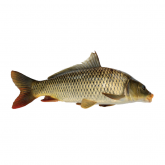Carp
If you see or catch carp outside of their known distribution, take a photo and report it online or call Biosecurity Queensland on 13 25 23.

Common carp
© Queensland Government

Koi carp
© Queensland Government

Mirror carp
© Queensland Government
Carp varieties (all the same species) present in Australian waters are:
- common carp
- koi carp
- mirror carp.
Carp were originally imported into Australia as game fish and have since spread throughout many waterways including the Murray-Darling Basin. It is illegal to keep carp as ornamental fish in Queensland.
Carp pose a major environmental threat, as they can rapidly outnumber native fish and greatly disturb aquatic environments through their destructive feeding habits. We are developing controls to reduce the number of carp in Australian waters.
The National Carp Control Plan explores the potential for biocontrol of carp in our waterways.
Carp is a restricted noxious fish under the Biosecurity Act 2014.
Scientific name
Description
- Large scales.
- Deeply forked tail.
- Single dorsal fin.
- 2 pairs of fleshy whiskers (or barbels) in the corners of upper lip. Barbels distinguish them from goldfish, which do not have them.
- Highly variable colour—bronze or olive-gold, becoming pale yellow or whitish on the sides and belly, or bright gold.
- Koi carp are often bright colours with dark blotches over their back.
- Can live up to 17 years.
Habitat
- Prefers warm, still waters with silt bottoms and abundant aquatic vegetation.
- Rarely found in clear, cool, swiftly flowing streams.
- Can survive in water:
- at high and low temperatures (4–35°C)
- with high salt
- that is turbid (cloudy)
- with low dissolved oxygen.
Distribution
- Native to central Asia.
- Introduced to Australia as a sportfish in the late 1800s.
- Widely distributed throughout south-eastern Australia with smaller populations in Western Australia and Tasmania.
- In Queensland, carp are found in the Murray-Darling River in the Condamine-Balonne catchment, Paroo River, Warrego River, Nebine Creek, Culgoa River, Barwon River and MacIntyre River. Also abundant in the Logan and Albert rivers south of Brisbane.
- Occasional reports of people illegally keeping koi carp in ornamental ponds around Queensland—this is illegal and fines apply.
Life cycle
Breeding
- Males are sexually mature between 1–3 years old, and females between 2–4 years old.
- Carp spawn between September and December.
- Produces up to 1.5 million eggs.
Diet
- Feeds by sucking up mud and plants from the bottom and blowing out what they don't want—known as 'roiling'.
- Adults feed on crustaceans, insects and plant material.
- Larval stages feed on plankton.
Impacts
Environmental
- Carp can survive in harsh environments in which native fish find it difficult to live.
- Their destructive feeding habits muddy the water and uproot aquatic vegetation (less light penetrates muddy water, reducing plant growth and lowering oxygen levels).
- Degraded water quality makes it more difficult for other species to survive.
Social
- Loss of favourite fishing locations due to carp invading and creating large monospecific (single species) fisheries.
Control
Monitoring and action
- If you catch carp in the wild, humanely kill them and do not return them to the water. If you see or catch carp outside of their known distribution, take photos and report it through our online reporting form.
- Follow the ethical euthanasia code in Euthanasia of animals used for scientific purposes (PDF, 1.8MB), the 2001 Australian & New Zealand Council for the care of animals in research and teaching publication. The most appropriate way may be to stun the fish with a sharp blow to the back of the head, just above the eyes. When done correctly, this causes brain destruction—the fish's gill covers should stop moving and eyes should remain still.
- Intensive fishing potentially reduces carp numbers in small enclosed waterbodies, but this practice alone is very unlikely to be effective for long-term control.
Poisoning
- Poisons can completely remove carp in ponds and small dams but are not practical for rivers and streams as these poisons also kill native fish.
Biological control
- Biological controls, such as introducing disease or modifying genes to disrupt breeding or cause death, are being investigated through the National Carp Control Plan.
Legal requirements
- Carp is a restricted noxious fish under the Biosecurity Act 2014.
- You must not keep, feed, give away, sell, or release carp into the environment without a permit.
- If you catch these species, you must immediately humanely kill and dispose of them responsibly away from the waterbody.
- By law, you have a general biosecurity obligation (GBO) to take reasonable and practical steps to minimise the risks associated with restricted noxious fish under your control.